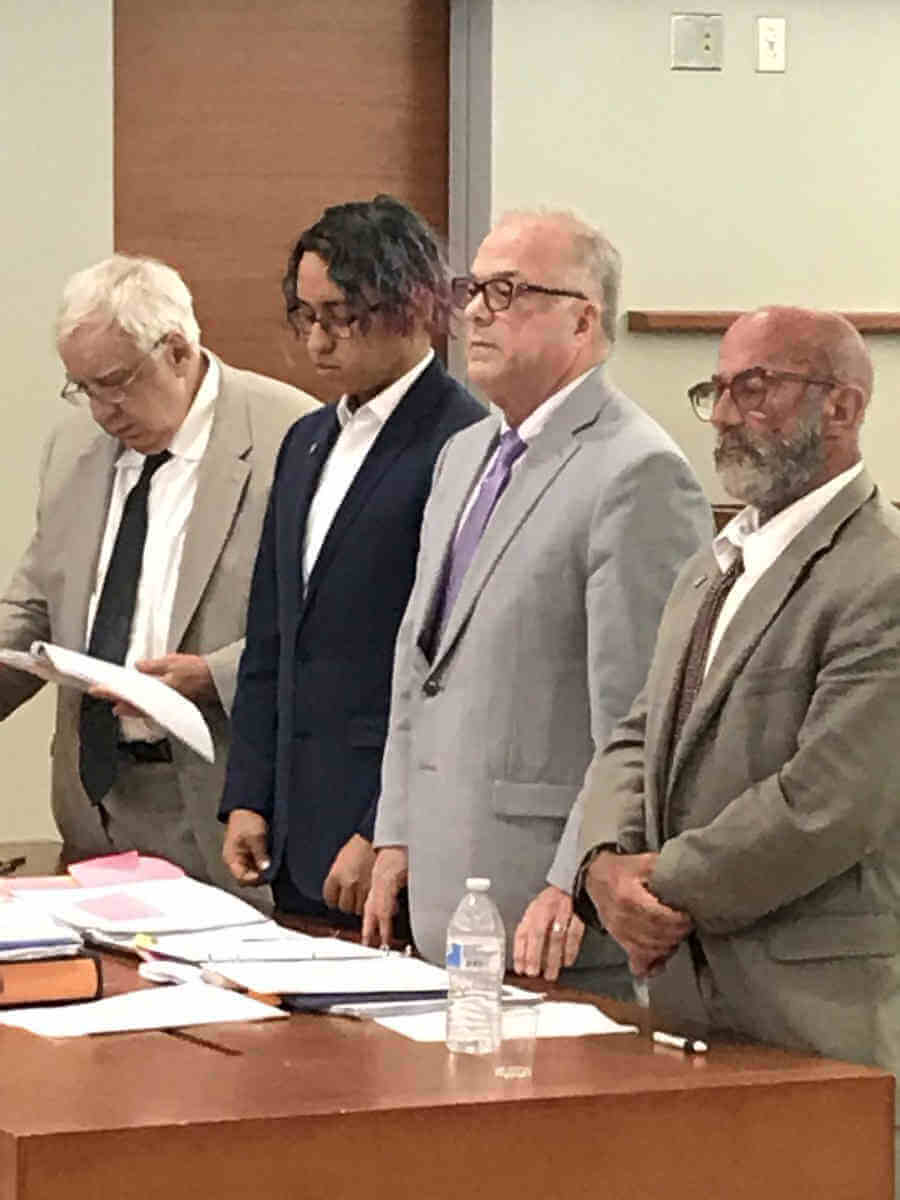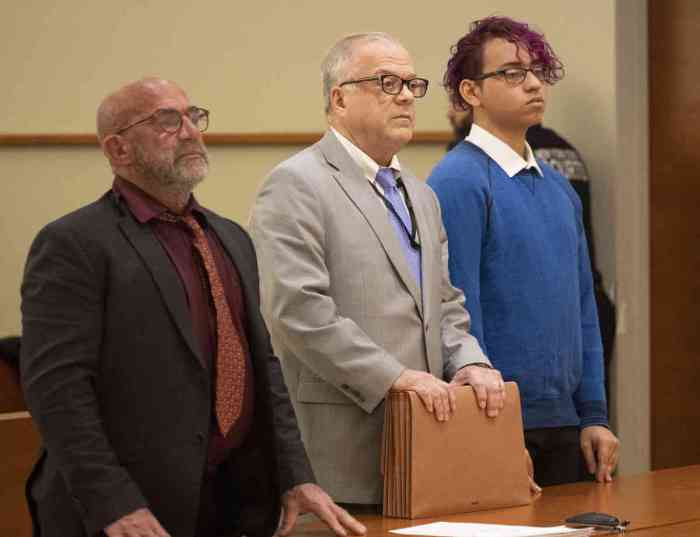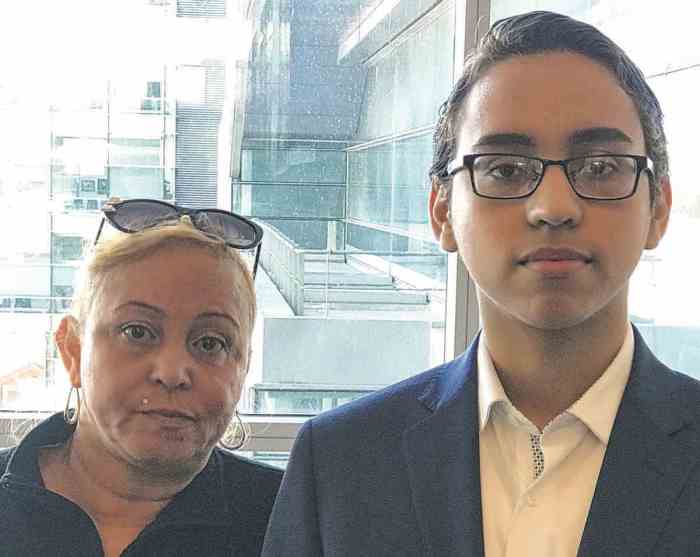Opening statements June 28 in the trial of Abel Cedeno, charged with manslaughter and assault for stabbing one classmate to death and seriously wounding another on September 27, 2017, saw the prosecution painting the defendant as a cold-blooded killer bent on coming to school to slice up some students.
To the defense, Cedeno is a bullied teen who at 18 brought a newly-purchased knife to school for protection after six years of anti-gay bullying and only used it when attacked by two tormentors — Matthew McCree, 15, who died with one cut to his heart, and Ariane LaBoy, then 16, who was slashed multiple times but survived.
Assistant District Attorney Nancy Borko called Cedeno a student “who didn’t bother to come to school” — ignoring the reasons for his extended absences due to bullying — “but came prepared with a knife.” After Cedeno tried to confront the bully or bullies in his class who threw things at him that day, Borko said, “he wanted to show his stuff.” She described McCree as “walking towards” Cedeno and “going at him” and “LaBoy trying to pull Matthew” away before getting slashed himself.
“He brought an illegal weapon to school and was looking for a chance to use it,” Borko said. (While no student is supposed to carry a knife to school, the legality of the weapon has yet to be established.) “He wanted to stand his ground and meet punches with deadly force,” she said.
Christopher R. Lynn, co-counsel for Cedeno, painted a very different picture of the fight, saying McCree “left his seat to go fight” with Cedeno as Cedeno angrily yelled at whoever was bullying him by throwing things at his head. “They drew first blood,” Lynn said. “Abel’s actions were purely defensive.” He described Cedeno’s “tortured history” as a student. “No wonder he didn’t want to go to school. I would not have gone either.”
Lynn described Cedeno as “the only gay kid in the school,” while Borko with a staff counselor witness from the Urban Assembly School for Wildlife Conservation, Shavon Evelyn, tried to paint it as a gay-friendly place where students got along even though it was closed shortly after the 2017 incident for having descended into chaos.
Lynn said that a friend of Cedeno’s had encouraged him to carry a knife by telling him, “That way they’ll leave you alone.” Lynn called the knife akin to a “box cutter” and said many students carry such knives. He said Cedeno believed that if there was a fight, “adults would stop it, but they did not” despite the presence of two teachers in the classroom of 25 students.
Cedeno surrendered the knife to Evelyn in the principal’s office. She testified that a subdued Cedeno said, “I shouldn’t have done it. I went too far.” Evelyn, who had counseled Cedeno for some time, said that she never filed a report to the Department of Education about the bullying he was subjected to, considering that the responsibility of the dean. (Indeed, many schools in New York report zero incidents of bullying each year.)
Borko introduced photos of the wounds suffered by LaBoy and the single three-inch slash of McCree’s chest that ended his life. Louna Dennis, McCree’s mother, left the courtroom at that point, distraught. Her attorney in a civil suit for $25 million against the city, Sanford Rubenstein, reported that she said, “He filleted my son like a fish!”

The prosecution is trying to paint Cedeno as having a history of violence, reading into the record reports of various fights he has had with family members. His family, including his mother Luz Hernandez, and sisters have been showing up for him at trial most every day.
The defense, notably attorney Robert J. Feldman, is trying to paint the victims as gang members that Cedeno feared — not because of any previous encounter with them but because of their reputations and their allegedly having beaten up a friend of his.
A soft-spoken student witness, Aanaiya Santiago, 17, testified on July 1 that the things being tossed at Cedeno were aimed at the garbage can next to the door where Abel was standing and were not aimed at him. She testified, “Abel then shouted, ‘Who threw the fucking paper’” and said that McCree stood up and said he was sorry and that it wasn’t meant for Abel who then, in her judgment, escalated the confrontation by calling them “pussies” and saying, “Pull up. Pull up!” to start a fight.
Santiago was not aware of what Cedeno has repeatedly testified to, including a statement to an ADA on the day of the incident that was played in court on July 2: that pencils and other debris was being thrown at his head early in the class causing him to leave the room twice before the fight. In another tape shown to the court, Cedeno showed police interrogators how he tried to defend himself from McCree and LaBoy — holding up his right hand with the knife as a warning (he is left-handed) and when he used it he was just waving it back and forth to ward off the attack.
Another student witness, Frankie Santiago, was asked repeatedly about whether he was aware of alleged gang connections that McCree and LaBoy had. The defense is trying to establish that Cedeno had particular reason to fear them when they attacked. But Judge Michael A. Gross sustained every prosecution objection to this line of questioning.
When Feldman tried to ask teacher witness Nikolai Kennedy about repeated reports he had allegedly filed on violent or disruptive incidents involving the victims, Gross sustained objections to that evidence, as well. Kennedy was in the front of the classroom when the fight took place and a nine-second cell phone video of it shows him no more than three feet away and then putting his hands on LaBoy’s shoulders at one point.
“I wanted the fight to stop,” he said.
As the video played in the courtroom, Kennedy said, “It looked like Matthew punched him” referring to Cedeno.
LaBoy testified on July 2, now 6”4” and 18 — though 6”1” and 16 at the time of the incident. He had great difficulty being heard in the courtroom and his testimony had to be read back by the court reporter at the request of the defense. He showed his multiple scars to the judge and that he was unable to raise his right arm above shoulder height. And when first asked to recount the incident, he put his head down and was unable to continue, leading the judge to call for a recess.

LaBoy said that when Cedeno first came into the class, Cedeno bumped his chair several times, “but I ignored it.” He said when Cedeno confronted the class about who was throwing things at him, his friend McCree said, “I threw it but I didn’t mean to hit you.” He said that Cedeno said, “Get up! I want to fight!” Cedeno has said in interviews that McCree said, “I did it. What’s up?,” that last phrase code for wanting to fight.
LaBoy said he grabbed McCree’s arm, “but he pushed off me.” After McCree came from the back of the room to confront Cedeno, he saw McCree “holding his chest.” LaBoy said he did not see a knife in Cedeno’s hand or McCree’s. The video shows LaBoy charging and punching Cedeno as well before getting stabbed himself.
Feldman in cross-examination embarked on an attempt to establish LaBoy’s gang connections, drug use, and poor school record — all questions that were objected to by the prosecution and sustained by Gross who — when LaBoy was out of the courtroom — severely admonished Feldman for the aggressiveness and “harassing” tone of his questions to the 18-year old victim. The judge termed the question “inappropriate” and “not an effective technique in order to develop evidence,” noting it especially wasn’t going to work with him in this bench trial where he is the sole arbiter of the facts. Gross will decide whether Cedeno, who faces up to 25 years on each count of manslaughter and assault, is guilty or not. It was a low point for the defense.
Subsequently, Lynn took over cross-examination.
Gross on July 1 barred the defense and prosecution from discussing the case with the press. Defense had been holding regular press briefings. While the prosecutors never speak with the press, they regularly consult with Rubenstein who represents McCree’s mother in a civil suit and holds press conferences several times a day on the case. On July 2, out gay attorney Tom Shanahan, who represents Cedeno and his family in a suit against the city, began attending the trial and offering comments to the press corps.
Rubenstein said that the defense of “justification,” or self-defense, cannot be used in a case where non-lethal violence is met with lethal violence or retaliation.
But Shanahan said, “Abel was not the aggressor, Matthew and Ariane were. Abel will testify about their propensity for violence” and how that could lead “a reasonable person” to defend him or herself with a knife.
Both Shanahan and Rubenstein agree that the fact that this all happened in a school is “unacceptable” from the inability to maintain order to the lack of enforcement of the anti-bullying regulations and the lack of metal detectors (something most students object to as treating them all like criminals). Rubenstein brought representatives from Black Lives Matter to argue for metal detectors and “restorative justice” and “empathy” programs. Shanahan said he was for all those things, but “you can’t teach empathy to a gang member.”
Late last week, Dr. Eric Goldsmith, a psychiatrist who evaluated Cedeno for the defense, testified that “at the time of the incident, Abel was in a highly traumatized state” and dealing with a “fight or flight” syndrome governed by hormones leading to involuntary actions. As Feldman said, “If he didn’t fight, he might have been killed.”

More prosecution witnesses were slated for July 3. The defense says that Cedeno will be the last witness in the trial.



































